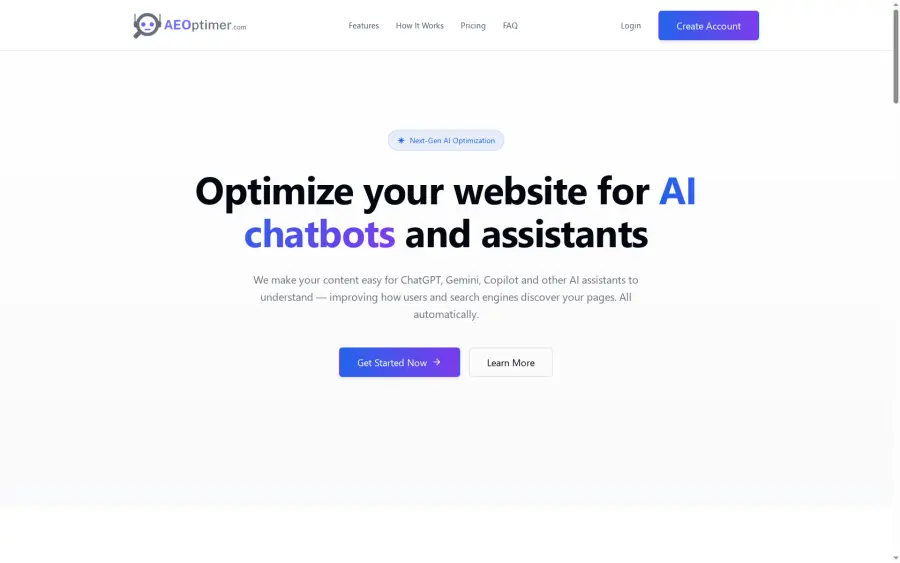7-Step Website Visibility Checklist for Maximum Reach

Did you know that over 90 percent of online experiences begin with a search engine? If your website struggles to appear when people search, you could miss out on valuable visitors and opportunities. Keeping your site healthy and visible means paying attention to key details like technical issues, clear content, and mobile performance. Simple improvements in these areas can help you reach the right audience and turn casual clicks into ongoing engagement.
Table of Contents
- 1. Run A Full Website Audit For Core Issues
- 2. Add Structured Data To Enhance Ai Recognition
- 3. Optimize Metadata For Search Clarity
- 4. Create And Submit An Updated Sitemap
- 5. Refresh And Update Content Frequently
- 6. Review Mobile And Speed Performance
- 7. Monitor Visibility And Refine Regularly
Quick Summary
| Takeaway | Explanation |
|---|---|
| 1. Conduct Regular Website Audits | Regular audits help identify issues affecting user experience and search performance, maintaining a healthy online presence. |
| 2. Implement Structured Data | Adding structured data improves content recognition by AI and search engines, enhancing digital visibility. |
| 3. Optimize Metadata for Engagement | Craft clear and compelling metadata to improve search rankings and click-through rates, attracting more visitors. |
| 4. Keep Content Fresh and Relevant | Regular updates signify activity to search engines and provide users with current, engaging information. |
| 5. Monitor Performance Metrics Regularly | Continuous monitoring of visibility, traffic, and user engagement is essential for ongoing website optimization and improvement. |
1. Run a Full Website Audit for Core Issues
A comprehensive website audit is your strategic roadmap to understanding and improving your online presence. According to research from Missouri State University, this process helps identify critical issues that might negatively impact user experience and search performance.
Why Conducting a Website Audit Matters
Website audits provide a holistic view of your digital ecosystem by examining multiple critical elements. According to Utah State University, this evaluation verifies the relevance, accuracy, and long-term stability of your website’s content and information assets.
Key Areas to Examine During Your Audit
Your website audit should comprehensively explore several essential domains:
- User Experience: Analyze navigation flow and engagement patterns
- Search Engine Optimization: Check metadata, keyword usage, and crawlability
- Technical Performance: Evaluate page load speeds and mobile responsiveness
- Content Relevance: Review information accuracy and audience alignment
- Accessibility: Ensure your site meets standard web accessibility guidelines
Practical Implementation Steps
To conduct an effective website audit, start by using free and professional tools. Google Analytics, Google Search Console, and specialized SEO platforms can provide deep insights into your website’s current performance. Pay special attention to broken links, page loading times, and user interaction metrics.
Pro Tip: Schedule website audits quarterly to stay ahead of potential issues and maintain optimal digital performance. Consistent review and optimization will help you create a more robust and user friendly online presence.
2. Add Structured Data to Enhance AI Recognition
Structured data acts as a secret language that helps AI tools and search engines understand your website content more precisely. By providing explicit context about your web pages, you can significantly improve your digital visibility and recognition.
What is Structured Data?
According to research from GeeksforGeeks, structured data provides clear signals about the meaning of webpage content, enabling better interpretation by AI systems and search engines. Think of it like adding subtitles to a movie that help viewers understand exactly what is happening.
Why Structured Data Matters
Traditional web content can be ambiguous for AI systems. Structured data eliminates this confusion by using standardized formats like Schema.org markup to define precise details about your content. Whether you have a blog, business website, or online store, structured data helps AI recognize:
- Content Type: Identifying whether content is an article, product, event, or review
- Key Information: Extracting specific details like prices, dates, and contact information
- Contextual Relationships: Understanding how different elements on a page connect
Practical Implementation Strategies
To add structured data effectively, use tools like Google’s Structured Data Markup Helper or JSON-LD generators. These platforms allow you to tag different content elements without requiring advanced coding skills. Focus on adding markup for key page elements such as:
- Business contact information
- Product details
- Article metadata
- Event specifics
Pro Tip: Test your structured data implementation using Google’s Rich Results Test tool to ensure proper recognition and formatting. Regular validation helps maintain optimal AI and search engine compatibility.
3. Optimize Metadata for Search Clarity
Metadata serves as the digital calling card for your web pages, providing search engines and potential visitors with a snapshot of your content. By crafting precise and compelling metadata, you can dramatically improve your website’s search visibility and user engagement.
Understanding Metadata Fundamentals
According to research from GeeksforGeeks, metadata optimization involves strategically crafting title tags and meta descriptions that accurately summarize page content. This approach directly impacts your search engine rankings and click-through rates.
Key Metadata Elements to Focus On
Effective metadata goes beyond simple descriptions. You want to create concise, informative snippets that immediately communicate your page’s value to both search algorithms and human readers:
- Title Tags: Capture the core message of your page in 50-60 characters
- Meta Descriptions: Provide a compelling summary in 150-160 characters
- Keywords: Naturally incorporate relevant search terms
- Page Purpose: Clearly articulate the unique value of your content
Practical Optimization Strategies
To optimize your metadata, think like a searcher. What would someone type into Google to find your content? Incorporate those exact phrases while maintaining readability. Use action-oriented language that creates curiosity and promises value.
Pro Tip: Regularly review and update your metadata. Search trends and user behaviors change quickly, so what worked six months ago might need refreshing. Tools like Google Search Console can help you track metadata performance and identify opportunities for improvement.
4. Create and Submit an Updated Sitemap
A sitemap is like a blueprint of your website that guides search engines through your digital landscape. By creating and submitting an updated sitemap, you ensure that every valuable page gets discovered and indexed efficiently.
Why Sitemaps Matter
Research from GeeksforGeeks highlights that sitemaps assist search engines in crawling and indexing website pages comprehensively. Think of your sitemap as a GPS for search engine robots helping them navigate your website’s complex terrain.
Understanding Sitemap Fundamentals
A sitemap is an XML file that lists all critical pages on your website. It provides essential information about each page such as:
- Page URL: The exact web address
- Last Modified Date: When the page was last updated
- Change Frequency: How often the page content changes
- Priority: Relative importance of the page within your site
Practical Sitemap Creation Steps
To generate an effective sitemap, use tools like Google Search Console or WordPress plugins that automatically create and update XML sitemaps. For smaller websites, online sitemap generators can quickly produce the required file. Ensure your sitemap includes only canonical URLs and excludes duplicate or low-value pages.
Pro Tip: Submit your sitemap directly to major search engines like Google and Bing through their webmaster tools. Update your sitemap whenever you add significant new content or make substantial website changes. Regular updates signal to search engines that your site is active and relevant.
5. Refresh and Update Content Frequently
Content is the heartbeat of your website. Regularly updating your digital content ensures your online presence remains vibrant, relevant, and engaging for both users and search engines.
The Power of Fresh Content
According to research from Missouri State University, frequent content updates dramatically improve website efficiency and visibility. Search engines reward websites that demonstrate consistent activity and relevance.
Why Content Refresh Matters
Regular content updates serve multiple strategic purposes beyond simply keeping information current. They signal to search algorithms that your website is active and valuable. Fresh content also provides:
- Improved Search Rankings: Shows search engines your site is current
- Enhanced User Engagement: Gives visitors reasons to return
- Opportunity for Optimization: Allows refinement of existing information
- Demonstration of Expertise: Highlights ongoing knowledge and insights
Practical Update Strategies
To maintain a dynamic website, develop a consistent content refresh approach. This could involve updating blog posts with new information, adding recent case studies, or revisiting older articles to include current statistics and trends. Aim to review and update your core content at least quarterly.
Pro Tip: Use content management tools to track update dates and set reminders. Consider creating a content calendar that schedules regular reviews and refreshes. This systematic approach ensures your website remains a living resource that continuously provides value to your audience.
6. Review Mobile and Speed Performance
In today’s digital world, your website’s mobile performance and loading speed are make or break factors for user engagement. A slow or poorly optimized site can send potential visitors running before they even see your content.
Understanding Performance Metrics
According to research from Utah State University, reviewing mobile and speed performance is crucial for ensuring website accessibility across different devices. Modern users expect instant access and seamless experiences regardless of their screen size.
Critical Performance Factors
Mobile and speed performance encompasses multiple technical and user experience elements:
- Loading Time: Aim for under 3 seconds load time
- Mobile Responsiveness: Ensure full functionality on smartphones and tablets
- Image Optimization: Compress graphics without losing quality
- User Interface Adaptability: Readable text and intuitive navigation on small screens
Practical Performance Evaluation Strategies
Utilize free tools like Google PageSpeed Insights, GTmetrix, and Mobile Friendly Test to diagnose performance issues. These platforms provide detailed reports on loading speeds, mobile compatibility, and specific recommendations for improvement. Pay special attention to elements that slow down your site such as large image files, complex scripts, and non optimized hosting environments.
Pro Tip: Performance optimization is an ongoing process. Schedule monthly performance reviews and immediately address any identified issues. Remember that even a one second improvement in loading time can significantly reduce bounce rates and improve user satisfaction.
7. Monitor Visibility and Refine Regularly
Website visibility is not a one time achievement but an ongoing journey of strategic monitoring and continuous improvement. Like a living organism, your digital presence requires constant attention and adaptation to remain competitive and relevant.
Understanding Digital Visibility
According to research from Missouri State University, ongoing assessment helps identify and address website issues promptly. This proactive approach ensures your online presence remains effective and engaging for your target audience.
Key Monitoring Focus Areas
To maintain robust website visibility, concentrate on tracking these critical performance indicators:
- Search Engine Rankings: Track position changes for target keywords
- Organic Traffic: Monitor visitor volume and source patterns
- User Engagement Metrics: Analyze time on site and interaction rates
- Conversion Performance: Review how effectively visitors complete desired actions
- Competitor Movements: Watch similar websites in your industry
Practical Monitoring Strategies
Leverage powerful analytics tools like Google Search Console, Google Analytics, and third party SEO platforms to gather comprehensive insights. Set up automated reports that deliver performance snapshots directly to your email. Create a monthly review process where you analyze these metrics and develop targeted improvement strategies.
Pro Tip: Treat website visibility as a continuous experiment. Small incremental improvements compound over time. Regularly test different approaches, track results, and be willing to pivot your strategy based on emerging data and audience behavior.
Below is a comprehensive table summarizing the strategies for enhancing website performance discussed throughout the article.
| Strategy | Implementation | Expected Results |
|---|---|---|
| Run a Full Website Audit | Analyze user experience, SEO, technical performance, content relevance, and accessibility. Use tools like Google Analytics and Search Console. | Identify critical issues, improve digital ecosystem, and enhance user experience. |
| Add Structured Data | Implement using tools like Google’s Structured Data Markup Helper. Focus on tagging key elements. | Improved AI recognition, better search engine understanding, and enhanced visibility. |
| Optimize Metadata | Craft precise title tags and meta descriptions, incorporate keywords and clear page value. | Increased search visibility, higher click-through rates, and improved user engagement. |
| Create and Submit an Updated Sitemap | Use XML sitemap tools and submit to search engines. Include only valuable and canonical URLs. | Efficient crawling and indexing by search engines, ensuring critical pages are discovered. |
| Refresh and Update Content Frequently | Develop a consistent update approach, using content calendars and management tools. | Enhanced search rankings, improved user engagement, and ongoing demonstration of expertise. |
| Review Mobile and Speed Performance | Use tools like Google PageSpeed Insights for diagnosis; focus on speed and optimization. | Reduced bounce rates, improved loading times, and better user satisfaction. |
| Monitor Visibility and Refine Regularly | Utilize analytics tools to track rankings, traffic, and engagement. Set up automated reports. | Continuous improvement, competitive edge, and effective online presence management. |
Boost Your Website Visibility with Automated AI-Ready Optimization
Struggling to keep up with the complex 7-step website visibility checklist is frustrating and time-consuming. From conducting full audits to adding structured data and constantly refreshing content, staying ahead requires effort and expertise. If you want to eliminate the headache of managing these core tasks while ensuring your site stays fully optimized for AI assistants like ChatGPT and Gemini, there is a smarter way.
aeoptimer.com simplifies this entire process by automating structured data addition, content updates, and sitemap management. With just a small script on your site, our platform performs monthly crawls and enhancements to keep your website aligned with evolving search trends and AI requirements without touching your design or code. This way you can focus on growing your business while we do the technical heavy lifting.
Take control now before visibility drops or your rankings fall behind competitors. Our platform ensures your pages remain discoverable and relevant to AI-driven search results.
Discover how aeoptimer.com empowers your website to effortlessly stay optimized for maximum reach.
Automate Your Website Visibility

Ready to maximize your AI and search engine visibility with zero hassle Sign up today at aeoptimer.com and let our automated system elevate your website to the next level of discoverability.
Frequently Asked Questions
How can I conduct a full website audit effectively?
To conduct a full website audit effectively, begin by analyzing key areas such as user experience, SEO, technical performance, content relevance, and accessibility. Use analytics tools to identify critical issues, and schedule audits quarterly to maintain optimal performance.
What types of structured data should I add to my website?
Focus on adding structured data that identifies your content type, such as articles, products, or events. This includes tagging elements like business contact information and product details to improve visibility and recognition by search engines within a few weeks after implementation.
How do I optimize metadata for better search clarity?
To optimize metadata, create compelling title tags of 50-60 characters and meta descriptions of 150-160 characters that summarize your content. Regularly refresh this information based on current search trends to enhance your visibility and click-through rates.
Why is it important to create and submit an updated sitemap?
Creating and submitting an updated sitemap is crucial as it helps search engines crawl and index your website efficiently. Ensure your sitemap includes only critical pages and update it whenever new significant content is added to keep search engines aware of your site’s changes.
How often should I refresh and update my content?
Aim to refresh and update your content at least quarterly to keep it relevant and engaging for your audience. Frequent updates demonstrate to search engines that your site remains active and can enhance your search rankings over time.
What metrics should I monitor to improve website visibility?
Monitor key metrics like search engine rankings, organic traffic, and user engagement rates to refine your visibility. Set up monthly reviews of these metrics to adapt your strategies and address any issues promptly.





